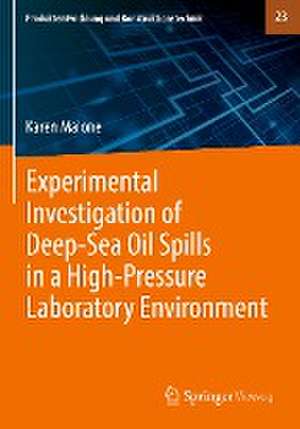Experimental Investigation of Deep‐Sea Oil Spills in a High‐Pressure Laboratory Environment: Produktentwicklung und Konstruktionstechnik, cartea 23
Autor Karen Maloneen Limba Engleză Paperback – feb 2024
| Toate formatele și edițiile | Preț | Express |
|---|---|---|
| Paperback (1) | 938.83 lei 43-57 zile | |
| Springer Nature Switzerland – feb 2024 | 938.83 lei 43-57 zile | |
| Hardback (1) | 944.19 lei 22-36 zile | |
| Springer Nature Switzerland – 31 ian 2023 | 944.19 lei 22-36 zile |
Preț: 938.83 lei
Preț vechi: 1144.91 lei
-18% Nou
Puncte Express: 1408
Preț estimativ în valută:
179.70€ • 195.26$ • 151.05£
179.70€ • 195.26$ • 151.05£
Carte tipărită la comandă
Livrare economică 21 aprilie-05 mai
Preluare comenzi: 021 569.72.76
Specificații
ISBN-13: 9783031255472
ISBN-10: 303125547X
Pagini: 126
Ilustrații: XXIV, 126 p. 61 illus., 58 illus. in color.
Dimensiuni: 168 x 240 mm
Greutate: 0.25 kg
Ediția:1st ed. 2023
Editura: Springer Nature Switzerland
Colecția Springer Vieweg
Seria Produktentwicklung und Konstruktionstechnik
Locul publicării:Cham, Switzerland
ISBN-10: 303125547X
Pagini: 126
Ilustrații: XXIV, 126 p. 61 illus., 58 illus. in color.
Dimensiuni: 168 x 240 mm
Greutate: 0.25 kg
Ediția:1st ed. 2023
Editura: Springer Nature Switzerland
Colecția Springer Vieweg
Seria Produktentwicklung und Konstruktionstechnik
Locul publicării:Cham, Switzerland
Cuprins
Introduction.- State of Knowledge.- Development of the High‐Pressure Test Center.- Experimental Determination of Oil Droplet Sizes in an Artificial Subsea Blowout.- Summary and Outlook.- References.
Notă biografică
Karen Malone studied Mechanical Engineering at Hamburg University of Technology and Luleå University of Technology, specializing in product development. From 2013 to 2018, she worked as research associate at the Institute of Product Development and Mechanical Engineering Design at TUHH. During this time, she took part in the international research consortium C-IMAGE which investigated the Deepwater Horizon Oil Spill and its consequences in and for the Gulf of Mexico. Since 2019, she works as process and plant engineer in the chemical industry.
Textul de pe ultima copertă
In the aftermath of the “Deepwater Horizon” oil spill in the Gulf of Mexico, the need arose for experimental data on oil and gas hydrodynamics and particle formation under deep-sea conditions. This work presents a new High-Pressure Test Center that allows for experimental oil spill research under artificial deep-sea conditions. It also contains experimental data on drop formation processes and oil drop size distributions generated within this test center and a modeling approach based on the turbulent energy dissipation that has been developed to predict the droplet sizes of an oil-and-gas jet under high pressure.
About the Author
Karen Malone studied Mechanical Engineering at Hamburg University of Technology and Luleå University of Technology, specializing in product development. From 2013 to 2018, she worked as research associate at the Institute of Product Development and Mechanical Engineering Design at TUHH. During this time, she took part in the international research consortium C-IMAGE which investigated the Deepwater Horizon Oil Spill and its consequences in and for the Gulf of Mexico. Since 2019, she works as process and plant engineer in the chemical industry.
About the Author
Karen Malone studied Mechanical Engineering at Hamburg University of Technology and Luleå University of Technology, specializing in product development. From 2013 to 2018, she worked as research associate at the Institute of Product Development and Mechanical Engineering Design at TUHH. During this time, she took part in the international research consortium C-IMAGE which investigated the Deepwater Horizon Oil Spill and its consequences in and for the Gulf of Mexico. Since 2019, she works as process and plant engineer in the chemical industry.
Caracteristici
Contains experimental data on droplet size distributions of high-pressure, deep-sea oil-in-water jets Introduces a modeling approach to predict oil droplet size distributions using the turbulent energy dissipation rate Presents a new test center for oil spill investigations under artificial deep-sea conditions










